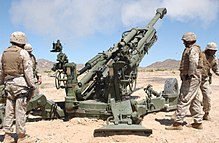This is an old revision of this page, as edited by Jeff F F (talk | contribs) at 21:53, 1 January 2007 (Updating design section with information on TAD). The present address (URL) is a permanent link to this revision, which may differ significantly from the current revision.
Revision as of 21:53, 1 January 2007 by Jeff F F (talk | contribs) (Updating design section with information on TAD)(diff) ← Previous revision | Latest revision (diff) | Newer revision → (diff) Towed howitzer| M777 Lightweight Towed Howitzer | |
|---|---|
 | |
| Type | towed howitzer |
| Place of origin | United Kingdom |
| Service history | |
| In service | 2005 - |
| Used by | USMC, Canada |
| Specifications | |
| Mass | 3,175kg. (7,000lb.) |
| Length | 10.7m (35ft.) in firing position; 9.5m (31ft. 2in.)towed position |
| Barrel length | n/a |
| Crew | 7 |
| Caliber | 155 mm |
| Carriage | split trail |
| Rate of fire | 2 to 5 round/min |
| Effective firing range | 30km |

The M777 howitzer is a towed artillery piece that is replacing the M198 howitzer in the US Marine Corps and US Army service by 2010. The M777 was developed by British BAE Systems Land Systems. It is currently being assessed in trials by the British Army as a candidate for replacing Light Gun in some Regiments.
Design
The M777 is lighter and smaller in size, weighing 9,200 lb (4.2 metric tons), 42% lighter than the M198 it replaces. Most of the weight reduction is due to the use of titanium. The lighter weight and smaller size allows the M777 to be transported by helicopter or truck with ease, allowing it to be moved in and out of the battlefield much quicker than the M198. The smaller size also improves storage efficiency in military warehouses. There is also a reduction in the gun crew size required; from 9 to 7.
Although developed by a British company, final assembly is in the USA. BAE System's original US partner was United Defense. However in 2005 BAE acquired UDI and hence is responsible for both design and construction (through its US-based Land and Armaments group). The M777 uses about 70% US built parts including the gun barrel. The Canadian Army is also in possession of twelve M777 and has deployed six units in support of combat operations in southern Afghanistan in 2006.
The M777 uses a digital fire control system similar to that found on self propelled howitzers such as the M109A6 Paladin to provide onboard ballistic computation, navigation, pointing and self-location, allowing it to be put into action more quickly than traditional towed and air-transported howitzers. This system called Towed Artillery Digitization (TAD) is produced by General Dynamics. The TAD system also includes a laser ignition system, electric drives for the howitzer's traverse and elevation and a powered projectile rammer.
Fielding
In May of 2005, 3rd Battalion, 11th Marines, based at Marine Corps Air Ground Combat Center Twentynine Palms, became the first Marine unit to begin fielding the new M777.

Over 600 systems will be supplied to the US Marine Corps, the US Army and National Guard.
In December of 2005 The 1st Regiment Royal Canadian Horse Artillery conducted an inaugural firing of its first 155 mm M777 towed howitzers. The six guns delivered were supplied by the United States Marine Corps under a Foreign Military Sales (FMS) contract between the U.S. and Canada. Four howitzers are now deployed to Afghanistan in support of Operation Archer. DND has now placed a follow-on order for six more guns with BAE Systems, with an option for a further twelve. Some of these will also be deployed to Afghanistan.
Specifications
As above and:
- Length:
- 30.4 ft (9275 mm) in tow
- 33.5 ft (10210 mm) firing mode
- Width:
- 9.1 ft (2770 mm) in tow
- 12.2 ft (3720 mm) firing mode
- Height: 7.4 ft (2260 mm) in tow
- Barrel life: 2650 firings
- Maximum effective range:
- conventional ammunition (unassisted): 24.7 km,
- rocket-assisted projectile: 30 km,
- Rate of fire:
- 5 round/min, rapid
- 2 round/min, sustained
References
- http://www.machinedesign.com/ASP/strArticleID/56460/strSite/MDSite/viewSelectedArticle.asp
- http://www.military.com/soldiertech/0,14632,Soldiertech_M777,,00.html
External links
- http://www.globalsecurity.org/military/systems/ground/lw155.htm
- http://www.sfu.ca/casr/bg-artillery-155mm-M777.htm